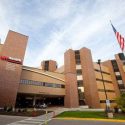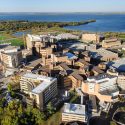With high-risk, high-reward investment, UW–Madison researcher seeks to outwit cancer’s resistance to treatment

UW–Madison Professor of Human Oncology Shuang (George) Zhao studies how cancers become resistant to treatment. He’s received a high-risk, high-reward grant from the National Institutes of Health in order to do so. Photo: Bryce Richter
MADISON – With funding from a National Institutes of Health 2021 High Risk, High Reward New Innovator Award, Shuang (George) Zhao, University of Wisconsin–Madison professor of human oncology, hopes to better understand why and how some cancers become resistant to treatment.
Cancer is a leading cause of death in the United States, and most of those deaths are the result of a patient’s tumor becoming resistant to available treatments. Similar to antibiotic resistance in which mutant bacteria that survive antibacterial drugs have a competitive advantage, just a few surviving human cancer cells with random genetic mutations that enable treatment evasion can repopulate a tumor and worsen disease.
The key to understanding this resistance is being able to compare how molecular characteristics of a person’s tumor cells change over time, says Zhao, who joined the UW–Madison faculty less than two years ago. However, the current approaches used for obtaining tumor samples for sequencing are limited to only capturing a single point in time.
“What we are less good at currently is looking before and after treatment to understand what is changing and how the cancer cells are evolving in response to treatment and how they might develop resistance to treatments,” Zhao explains. “So, the goal of our grant project is to really characterize how resistance develops over time across cancer types.”
An approach called liquid biopsy offers an alternative to invasive tissue biopsies to obtain tumor specimens for study. It allows researchers to obtain data from tumor cells circulating in the blood by testing blood samples multiple times before, during and after treatment. The bulk of the newly funded efforts will go into sequencing the samples’ genetic material (DNA and RNA) and performing computational analysis to detect newly arising mutations in tumor cells.
This will allow the researchers to map changes in individual tumors that became resistant and discern possible common mechanisms of resistance across multiple tumors.
“You can’t optimally treat a disease until you actually understand what is happening at a molecular level,” says Zhao, who holds a medical doctorate and trained in radiation oncology. “It is an open question if each individual person’s cancer has a unique alteration, or if there are common shared mechanisms that account for resistance across tumors.”
The UW–Madison-led team has performed some of its successful preliminary work in prostate cancer. With a grant for the innovative work, which may have been riskier to fund through the traditional peer-review process, Zhao’s research groups can further their research by gathering and sequencing more samples across different types of cancer.
The reward could be rapid advances in patient care options tailored to outwit the resistance of their cancer to treatment. Being able to understand why and how cancer cells develop resistance is key so researchers and physicians aren’t shooting in the dark during a race against time. If a doctor knows that a treatment option is one the cancer will resist, they can try different, more effective options earlier on before the patient becomes sicker, Zhao says.
“With more resources, this will truly jumpstart our efforts across a number of different cancer types,” he adds. “As a physician, I see these patients in my clinic every single day, and I always wish that we had more to offer them. I hope that our work will be able to meaningfully improve the treatments we offer our patients.”
Zhao is one of only 106 researchers nationally to earn a grant for high-risk, high-reward research from the NIH this year; 64 of the grants are New Innovator Awards. The awards provide $1.5 million for unusually innovative research done by early career investigators. The program helps support research proposals with high potential for success and advancement, but which also may have less guarantee than other projects.
Read more in this news release from NIH.



